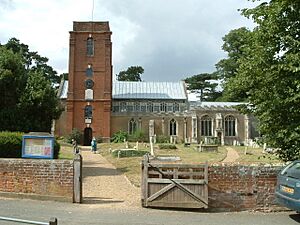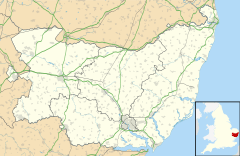Grundisburgh facts for kids
Quick facts for kids Grundisburgh |
|
|---|---|
 St Mary's Church, Grundisburgh |
|
| Population | 1,584 (2011) |
| OS grid reference | TM223509 |
| District |
|
| Shire county | |
| Region | |
| Country | England |
| Sovereign state | United Kingdom |
| Post town | WOODBRIDGE |
| Postcode district | IP13 |
| Dialling code | 01473 |
| Police | Suffolk |
| Fire | Suffolk |
| Ambulance | East of England |
| EU Parliament | East of England |
| UK Parliament |
|
Grundisburgh is a village in Suffolk, England. About 1,584 people live here. It is located in the East Suffolk area. The village is about 6 miles (10 km) northeast of Ipswich and 4 miles (6 km) northwest of Woodbridge. The rivers Lark and Gull flow through Grundisburgh.
People have lived in this area since the Middle Saxon era, which was a very long time ago! The village is mentioned in a very old book called the Domesday Book from 1086. Its name was spelled a bit differently back then, like "Grundesbur". Grundisburgh is pronounced "Gruns-bruh".
The village has a primary school, a Church of England church, and a Baptist chapel. There is also a pub called The Dog. Volunteers publish a local newspaper called The Grundisburgh and District News every three months. It shares news for Grundisburgh and nearby small villages. You can also find two fords (shallow places where a river can be crossed) in the village. The village is even the setting for a novel called A Wicked Deed by Susanna Gregory.
Contents
Grundisburgh Primary School
Grundisburgh Primary School is a medium-sized school. It had 131 students during its last inspection. The school is in a modern building on Alice Driver Road. This building was built in 1989. Before that, the school was in the Old School building next to St Mary's Church for 115 years. The Old School building is now used for affordable homes.
What Does the Name Grundisburgh Mean?
The name "Grundisburgh" comes from Old English words. It means a burh, which was a fortified or protected place. This "Burh" might refer to an Iron Age fort nearby. There are also remains of a Roman fort around the church in the next village, Burgh. This fort stands on a hill overlooking the valley where Grundisburgh is.
One idea is that "Grund" was the old name for the area. It might come from an Old English word meaning "foundation," referring to the Roman walls. So, Grundisburgh could mean "the Burgh at Grund." Another idea is that grund simply means land or lower ground. This would make the name mean "Burgh-in-the-valley," meaning the part of the Burgh settlement that is in the valley.
Village Government
Grundisburgh is part of an electoral ward (a local voting area) that also includes parts of Kesgrave. This ward has a total population of 2,306 people.
Famous People from Grundisburgh
Some interesting people were born or lived in Grundisburgh:
- Bartholomew Gosnold (1571–1607) was an explorer. He helped settle Virginia in America. He also named famous places like Martha's Vineyard and Cape Cod.
- George William Lyttelton was a teacher of classics and English literature at Eton.
- Alice Driver was one of the Ipswich Martyrs in the 1500s. She was executed for her Protestant beliefs in 1558.
- Sir Charles Blois, 1st Baronet was a Tory Member of Parliament for Ipswich and Dunwich.
Cool Buildings in Grundisburgh
Grundisburgh has 27 listed buildings. This means they are special buildings protected for their history or architecture. One building is Grade I listed, which is the highest protection, and one is Grade II* listed.
- Basts: This is a Tudor building built around 1520. It's located just east of the church.
- St Mary's Church: This is the main church in the village. It's a Church of England church. Records show it existed as early as 1254. The oldest parts of the church are from around 1300. It was made bigger in the 1400s. Inside, you can see a beautiful Suffolk hammerbeam roof and a large painting of St Christopher from the 1300s.
- In 1527, a part called the Lady Chapel was added or fixed up.
- A special feature of the church is its brick tower from the 1700s. It was built between 1731 and 1732.
- A Millennium Time Capsule was sealed into the tower wall in the year 2000.
- Grundisburgh Baptist Chapel: This Baptist chapel was built in 1798. It is one of the oldest non-Church of England religious buildings in the area. It has been updated recently, with new seats replacing the old wooden pews.
- Old Mills: Post Mill Gardens is where a post mill (a type of windmill) stood. It was built in 1807 and worked until 1930. The remains were later made into part of a house. Another smaller windmill, a miniature smock mill, was nearby from about 1885 until it was taken down around 1957.
See also
 In Spanish: Grundisburgh para niños
In Spanish: Grundisburgh para niños


